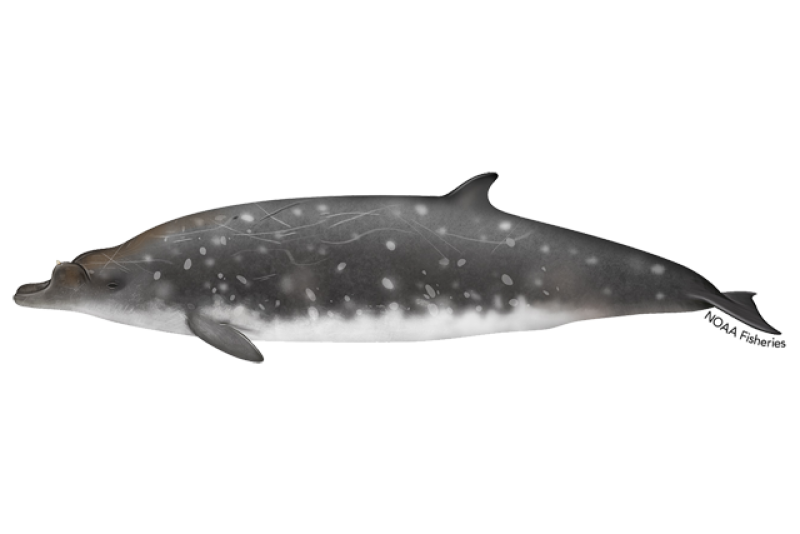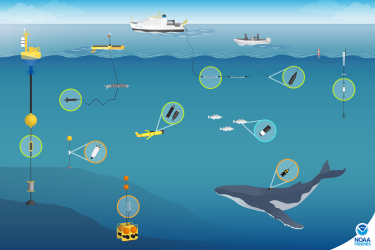Pygmy Sperm Whale
Kogia breviceps
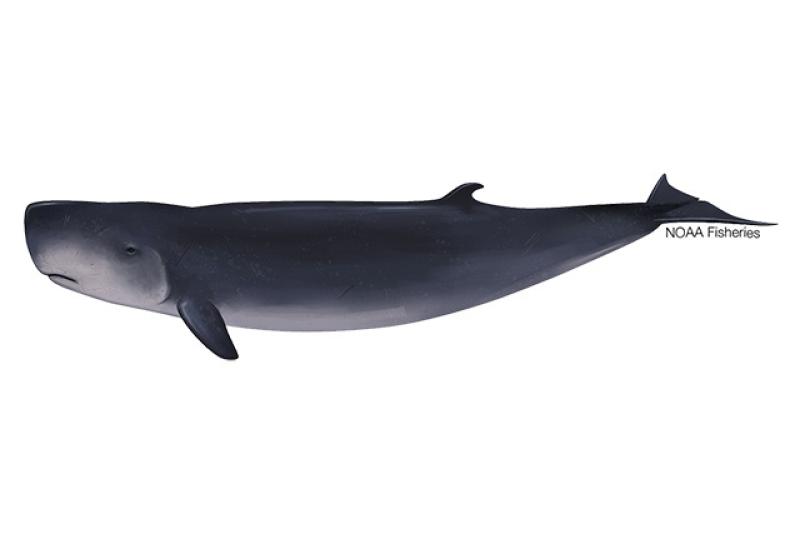
Protected Status
Quick Facts
About the Species
Pygmy sperm whales are toothed whales named after the waxy substance—spermaceti—found in their heads. The spermaceti is an oil sac that helps the whales focus sound. Like squid, pygmy sperm whales can produce a dark, ink-like liquid that helps them escape from predators.
Pygmy sperm whales are found in temperate and tropical seas worldwide. They look very similar to dwarf sperm whales, making it very difficult to distinguish between the two species in the field. Little is known about both species because of limited information, and they are considered rare.
Pygmy sperm whales, like all marine mammals, are protected under the Marine Mammal Protection Act. NOAA Fisheries and its partners are working to conserve pygmy sperm whales and further our understanding of this species through research and conservation activities.
Population Status
NOAA Fisheries estimates population size in its stock assessment reports.
Pygmy sperm whales usually avoid vessels and planes, the tools that our scientists use to measure population size. Additionally, the whales only come to the water’s surface when the sea and weather conditions are very calm. As a result, scientists rarely see pygmy sperm whales at sea. This makes it difficult to estimate their minimum population size or current population trends.
Appearance
Pygmy sperm whales have a small, compact body with a small and rounded dorsal fin. Each individual whale’s dorsal fin is a slightly different shape. While on the water’s surface, pygmy sperm whales have a low profile because their head and back are somewhat flat. Their head is sometimes described as shark-like because of their pointed snout and narrow, underslung lower jaw.
Pygmy sperm whales have wrinkled skin and a brown to blue-gray back. Their underside is paler with white or pink tones. They do not have teeth in their upper jaw but have 10 to 16 pairs of teeth in the lower jaw. Their eyes are dark and bulging, and they have a marking behind the eye that is often called a false gill because it looks like a fish's gill cover or slit.
Pygmy sperm whales can sometimes be confused with dwarf sperm whales, their closest relative. These two types of whales were not distinguished as separate species until 1966. In the wild, it is very difficult to distinguish between them because they have similar appearances and geographic ranges.
Behavior and Diet
Pygmy sperm whales are usually seen either alone or in small groups of six to seven individuals. These groups can vary based on age and sex, but little else is known about their social organization.
Pygmy sperm whales spend very little time at the water’s surface and almost never approach vessels. When they are seen at the surface, they are usually either swimming slowly or lying still (also known as “logging”). They will slowly sink and disappear from view without showing their flukes before diving back into the water. While they do have a blowhole, they do not have a visible blow at the surface.
Pygmy sperm whales’ use of the "squid tactic" makes them unique among other types of whales except dwarf sperm whales. Each pygmy sperm whale has a sac filled with dark liquid in its intestine. The whale can release more than 3 gallons of dark, reddish-brown liquid, or “ink,” from this sac. The liquid creates a dark cloud in the water to help protect the whales when they feel threatened or are trying to escape predators.
Pygmy sperm whales can dive at least 1,000 feet in search of food. They typically feed in mid- and deep-water environments, as well as near the ocean floor. They eat cephalopods (e.g., squid and octopus), crustaceans (e.g., crabs and shrimp), and fish. The whales use echolocation to locate prey. This means that, like bats, pygmy sperm whales use sound to navigate and "see" the world around them. They do so by producing sounds from their melons (or foreheads) that reflect off the objects around them, which the whales perceive as echoes.
Where They Live
Pygmy sperm whales have a wide distribution. They live in tropical, subtropical, and temperate waters in oceans and seas around the world. They are most common off coasts and along continental shelves (the edges of continents lying under the ocean).
In the United States, pygmy sperm whales live off the coasts of Hawaiߵi, the Pacific Northwest, the North Atlantic, and the northern Gulf of America (formerly Gulf of Mexico). They may be most common off the southeastern coasts, as the most strandings have occurred there.
In the Southern Hemisphere, pygmy sperm whales live in the Tasman Sea and the waters around Chile, South Africa, and Uruguay. In the Northern Hemisphere, they live in the waters around the Netherlands, northwestern Europe, the Azores, Nova Scotia, and Japan. Their migration patterns are currently unknown.
Lifespan & Reproduction
Pygmy sperm whales can live up to 23 years. They reach sexual maturity when they are 4 to 5 years old. The mating and calving season lasts about 9 months and peaks in March through August in the Northern Hemisphere. Pregnancy lasts for about 9 to 11 months, and females can give birth multiple years in a row. Calves are weaned after 1 year.
Threats
Entanglement in Fishing Gear
One of the main threats to pygmy sperm whales is becoming entangled or captured in commercial fishing gear such trap lines, pots, and gillnets. Once entangled, they may swim for long distances dragging attached gear, potentially resulting in fatigue, compromised feeding ability, or severe injury. These conditions can lead to reduced reproductive success and death.
Hunting
Historically, pygmy sperm whales were hunted during the 19th century. While they are no longer hunted in the United States, commercial harpoon fisheries in Indonesia, the Lesser Antilles, and Japan continue to take pygmy sperm whales.
Vessel Strikes
Accidental vessel strikes can injure or kill pygmy sperm whales. They are vulnerable to vessel strikes throughout their range, but the risk is higher in some areas with heavy ship traffic.
Marine Debris
Like many marine animals, pygmy sperm whales can ingest marine debris. They could mistake debris in the deep scattering layer where they feed for prey and incidentally ingested it, leading to possible injury or death. Some stranded pygmy sperm whales have been found with plastic and other garbage blocking their guts.
Ocean Noise
Underwater noise pollution can interrupt the normal behavior of pygmy sperm whales, which rely on sound to communicate. As ocean noise increases from human sources, communication space decreases; the whales cannot hear each other, or discern other signals in their environment as they used to in an undisturbed ocean.
Different levels of sound can disturb important activities, such as feeding, migrating, and socializing. Mounting evidence from scientific research has documented that ocean noise also causes marine mammals to change the frequency or amplitude of calls, decrease foraging behavior, become displaced from preferred habitat, or increase the level of stress hormones in their bodies. If loud enough, noise can cause permanent or temporary hearing loss.
Scientific Classification
| Kingdom | Animalia | Phylum | Chordata | Class | Mammalia | Order | Cetacea | Family | Kogiidae | Genus | Kogia | Species | breviceps |
|---|
Last updated by NOAA Fisheries on 02/26/2025
What We Do
Conservation & Management
Pygmy sperm whales, like all marine mammals, are protected under the Marine Mammal Protection Act. Targeted management actions we undertake for these whales include:
- Reducing entanglement in fishing gear
- Addressing ocean noise
- Reducing vessel strikes
- Overseeing marine mammal health and stranding response
- Minimizing whale watching harassment
Science
Our research projects have discovered new aspects of pygmy sperm whale biology, behavior, and ecology and help us better understand the challenges that all pygmy sperm whales face. Our work includes:
- Stock assessments
- Monitoring population abundance and distribution
- Acoustic science
How You Can Help
Report Marine Life in Distress
Report a sick, injured, entangled, stranded, or dead animal to make sure professional responders and scientists know about it and can take appropriate action. Numerous organizations around the country are trained and ready to respond. Never approach or try to save an injured or entangled animal yourself—it can be dangerous to both the animal and you.
Learn who you should contact when you encounter a stranded or injured marine animal
Reduce Speed and Be on the Lookout
Vessel collisions are a major cause of injury and death for whales. Here are some tips to avoid collisions:
Be Whale Aware. Know where whales occur (habitat).
Watch your speed in areas of known marine mammal occurrence. Keep speeds to 10 knots or less to reduce potential for injury.
Keep a sharp lookout. Look for blows, dorsal fins, tail flukes, etc. However, be aware that most captains report never seeing a whale prior to colliding with it.
Protect your boat, protect your passengers. Boats can be heavily damaged and even "totalled" after colliding with a large whale. Collisions can also injure passengers.
Keep your distance. Stay at least 100 yards away.
Stop immediately if within 100 yards. Slowly distance your vessel from the whale.
Keep Your Distance
Be responsible when viewing marine life in the wild. Observe all small whales from a safe distance of at least 100 yards and limit your time spent observing to 30 minutes or less.
Report a Violation
Call the NOAA Fisheries Enforcement Hotline at (800) 853-1964 to report a federal marine resource violation. This hotline is available 24 hours a day, 7 days a week for anyone in the United States.
You may also contact your closest NOAA Office of Law Enforcement field office during regular business hours.
Featured News
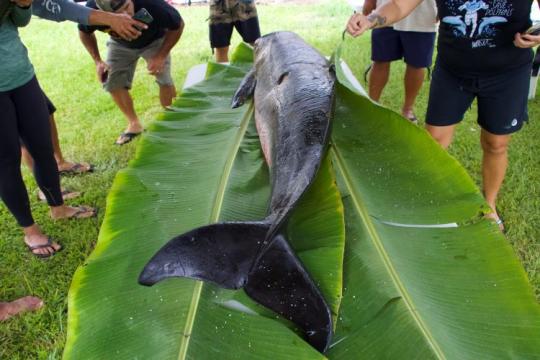 Kiaʻi Kanaloa and Hui Hoʻoleimaluō members respond to a stranded palaoa (whale), a Kogia calf, on Hawaiʻi Island. Their efforts are part of a new and developing stranding response partnership with NOAA Fisheries. Credit: Kiaʻi Kanaloa (NOAA Fisheries Permit #24359)
Kiaʻi Kanaloa and Hui Hoʻoleimaluō members respond to a stranded palaoa (whale), a Kogia calf, on Hawaiʻi Island. Their efforts are part of a new and developing stranding response partnership with NOAA Fisheries. Credit: Kiaʻi Kanaloa (NOAA Fisheries Permit #24359)

 Rice's Whale. Credit: NOAA Fisheries
Rice's Whale. Credit: NOAA Fisheries
Protecting Species While Planning for Offshore Wind Development in the U.S. Gulf of Mexico
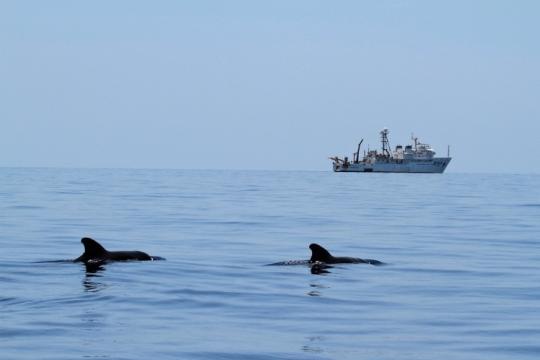 Pilot whales surface near the NOAA Ship Gordon Gunter. Credit: NOAA Fisheries/Melody Baran (Permit # 14450)
Pilot whales surface near the NOAA Ship Gordon Gunter. Credit: NOAA Fisheries/Melody Baran (Permit # 14450)
Management Overview
The pygmy sperm whale is protected throughout its range under the Marine Mammal Protection Act.
Additionally, the pygmy sperm whale is listed under:
- Appendix II of the Convention on International Trade in Endangered Species of Wild Fauna and Flora (CITES)
- Annex II of the Protocol for Specially Protected Areas and Wildlife (SPAW)

Conservation Efforts
Reducing Entanglement in Fishing Gear
Entanglement in fishing gear is a primary cause of serious injury and death for many whale species, including pygmy sperm whales.
In the Pacific, we implemented the Pacific Offshore Cetacean Take Reduction Plan to reduce mortalities and serious injuries of several marine mammal stocks, including pygmy sperm whales, incidentally injured in the California thresher shark/swordfish drift gillnet fishery.
Addressing Ocean Noise
Underwater noise threatens whale populations, interrupting their normal behavior and driving them away from areas important to their survival. Increasing evidence suggests that exposure to intense underwater sound in some settings may cause some whales to strand and ultimately die. NOAA Fisheries is investigating all aspects of acoustic communication and hearing in marine animals, as well as the effects of sound on whale behavior and hearing. In 2016, we issued technical guidance for assessing the effects of anthropogenic (human-caused) sound on marine mammals’ hearing.
Reducing Vessel Strikes
Collisions between whales and large vessels can injure or kill the whales and damage the vessels, but they often go unnoticed and unreported. The most effective way to reduce collision risk is to keep whales and vessels apart. If this is not possible, the second-best option is for vessels to slow down and keep a lookout.
In the Atlantic, we have taken both regulatory and non-regulatory steps to reduce the threat of vessel collisions to North Atlantic right whales, which may also reduce the threat to pygmy sperm whales. The steps include:
- Requiring vessels to slow down in specific areas during specific times (seasonal management areas)
- Advocating for voluntary speed reductions in dynamic management areas
- Recommending alternative shipping routes and areas to avoid
- Modifying international shipping lanes
- Developing mandatory vessel reporting systems
- Increasing outreach and education
- Improving our stranding response
Learn more about reducing vessel strikes
Overseeing Marine Mammal Health and Stranding Response
We work with volunteer networks in all coastal states to respond to marine mammal strandings including all whales. When stranded animals are found alive, NOAA Fisheries and our partners assess the animal’s health and determine the best course of action. When stranded animals are found dead, our scientists work to understand and investigate the cause of death. Although the cause often remains unknown, scientists can sometimes attribute strandings to disease, harmful algal blooms, vessel strikes, fishing gear entanglements, pollution exposure, and underwater noise. Some strandings can serve as indicators of ocean health, giving insight into larger environmental issues that may also have implications for human health and welfare.
Learn more about the Marine Mammal Health and Stranding Response Program
Marine Mammal Unusual Mortality Events
Pygmy sperm whales have been part of a declared unusual mortality event in the past. Under the Marine Mammal Protection Act, an unusual mortality event is defined as "a stranding that is unexpected; involves a significant die-off of any marine mammal population; and demands immediate response." To understand the health of marine mammal populations, scientists study unusual mortality events.
Regulatory History
Pygmy sperm whales, like all marine mammals, are protected in the United States under the MMPA.
Key Actions and Documents
Last updated by NOAA Fisheries on 02/26/2025
Science Overview
NOAA Fisheries conducts various research activities on the biology, behavior, and ecology of the pygmy sperm whale. The results of this research are used to inform management decisions for this species.
Stock Assessments
Determining the size of pygmy sperm whale populations helps resource managers determine the success of conservation measures. Our scientists collect population information and present the data in annual stock assessment reports.
Monitoring Population Abundance and Distribution
Scientists observe pygmy sperm whales to record their numbers and distribution. By comparing numbers collected over multiple years, scientists can look for trends—i.e., whether the population is increasing, decreasing, or remaining stable during a given period.
Acoustic Science
Other research focuses on the acoustic environment of cetaceans, including pygmy sperm whales. Acoustics is the science of how sound is transmitted. This research involves increasing our understanding of the basic acoustic behavior of whales, dolphins, and fish; mapping the acoustic environment; and developing better methods to locate cetaceans using autonomous gliders and passive acoustic arrays.
More Information
Recent Science Blogs
Last updated by NOAA Fisheries on 02/26/2025
Data & Maps
Passive Acoustic Cetacean Map
This mapping tool shows when and where specific whale, dolphin, and other cetacean species were…
Research
A Decade of Declines in Toothed Whale Densities Following the Deepwater Horizon Oil Spill
We document decadal density declines for seven of eight monitored species groups, including sperm…
Passive Acoustics Research Group News & Media
Our Passive Acoustics Research Group frequently makes the news. This page links to articles and other media featuring our staff and their research.
Last updated by NOAA Fisheries on 02/26/2025



